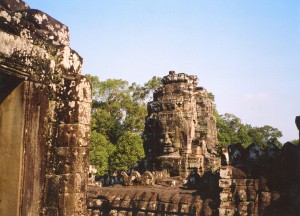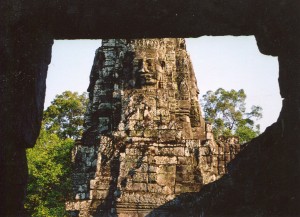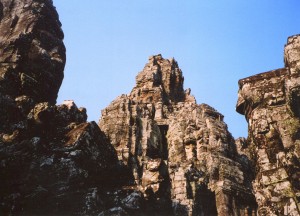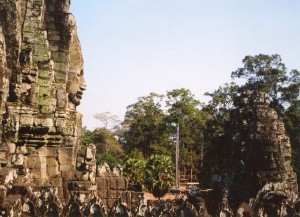We’ll now approach the center of the Bayon and explore some of the great temple’s inner meanings.
One of its many face-towers (above) keeps the state in order–can they build a few of them in Washington D.C. and on Wall Street?
When I ascended to the Bayon’s upper terrace, these towers were densely clustered. King Jayavarman VII envisioned the Bayon as Angkor’s center, so I was entering the most important place in the Khmer universe when it was at the height of its power.
Who do the faces represent? Most guidebooks say that they’re the Mahayana deity Lokesvara carved in Jayavarman’s likeness. But not everyone agrees. This complex monument still holds lots of mysteries.
I had mixed feelings up there, as I did in the Bayon’s lower gallery of sculptures. The faces on the towers are both gentle and aloof. They radiate compassion throughout the land, but walking around them felt humbling. Their size is way beyond ours. You look up and they gaze into the vast distance. They seem more concerned with the whole universe than a single dude.
I then approached the center of it all. A line of connecting rooms within the central tower leads to the middle chamber. The room is circular, and it once housed an enormous statue of the Buddha. A narrow hall wraps around this space, and 8 rooms project from it like lotus petals. Specialists have seen this configuration as a mandala, and it thus might embody the early universe’s emanation.
It’s a pretty form, but the interior was dark and constricting, with bats darting overhead. An elderly priest sat in the middle and took offerings from a few locals. The air was very stuffy.
The Bayon has contrasting personalities, and walking around its gallery of sculptures and towards its center feels like a flight through the universe. But the Bayon has uniquely Khmer characteristics:
1. The Bayon blends many deities. Europe’s gothic cathedrals express one theology in a linear order that takes you past Biblical personalities and towards Jesus and the Father. But the Bayon, which the Khmers built at the same time, blends Mahayana Buddhism, Jayavarman VII’s royal cult, Hinduism and local ancestral cults (which the outer gallery housed). Most Southeast Asian religions are flexible, and they can mix many theologies.
2. Jayavarman built the Bayon in a time of mixed feelings. The empire was reaching its fullest extent, and it covered most of mainland Southeast Asia. But he built the Bayon after devastating wars with the Cham (from Vietnam) and several succession crises. So it’s not surprising that the monument projects both confidence and an insecure desire to control the empire with vice-grip strength.
Hang out at the Bayon for a while, and you’ll be immersed in the Khmers’ complex and multifaceted world.






Comments on this entry are closed.